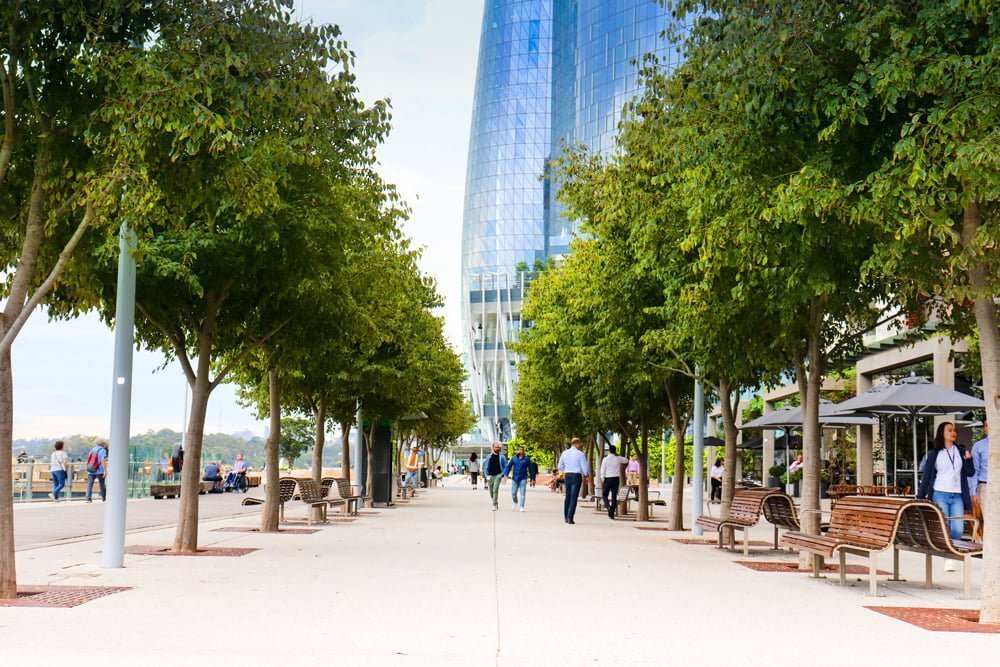Las Vegas metro area could be biggest winner in cooling power of trees
from the RGJ and Nevada Current
Las Vegas is heating up faster than almost every other American city, but a new multi-year study may provide local governments some direction for effective heat relief.
According to a study published by the U.S. Geological Survey last week, Las Vegas and other cities in hotter, drier regions may be the biggest winners when it comes to the cooling effect trees can provide in sizzling temperatures.
In eight large cities across the country, scientists placed 80 to 100 sensors on trees in each city and measured hourly air temperatures for three months during the summers of 2016 to 2019. The study found that urban trees in arid cities amplified the cooling of local air temperature significantly more than in more humid locations, according to Nevada Current.
The study covered Baltimore, Los Angeles, Phoenix, Portland, Miami, Tucson, Denver and Las Vegas.
“We found that trees in every city are reducing air temperature. But we did find that the hotter and drier the city, the greater the magnitude of that cooling power was,” said Peter Ibsen, USGS research ecologist and the study’s lead researcher.
For example, in humid Miami, researchers found that trees cooled the surrounding air temperatures by about 2 degrees C (Celsius), while trees in the Las Vegas metro area accounted for a 7-degree C cooling effect. The study measured cooling effects over a 60-meter buffer around each tree, indicating a broader impact of tree canopy on air temperature.
“Trees, when you put up them all over the whole city, they have this larger effect of being able to reduce air temperature at the neighborhood scale,” Ibsen said.
Trees in hotter, drier cities like Las Vegas also consistently mitigated air temperature increases during periods of extreme heat, meaning trees can substantially alter residents’ exposure to extreme heat in urban areas.
“We’re seeing a ton of cooling coming from trees in Las Vegas. And when we did a whole model accounting for heat waves in Las Vegas, that cooling effect increased during heat waves as well,” Ibsen said.
Average summertime temperatures in Las Vegas have increased by 5.8 degrees F since 1970, ranking as the second fastest-warming city in the U.S.
Extreme heat waves in Southern Nevada have exacerbated heat-related hospitalizations and deaths year-after-year. Last year, Clark County reported more than 300 heat-related deaths. In 2024, the county said heat was a factor in more than 400 deaths.
Las Vegas recorded its hottest temperature ever — 120 degrees F— on July 7, 2024. That same day, the youngest person in Clark County to die of a heat stroke was a 27-year-old man, according to the Clark County coroner. The second hottest day ever recorded in Las Vegas — 119 degrees F — happened two days later, where the youngest person to die of heat stroke was a 28-year-old man.
Heat related deaths are often associated with the sick and elderly, but at a certain temperature the human body can’t withstand extreme heat, and neither a person’s state of fitness nor their levels of hydration can protect them from heat damage.
Finding trees that aren’t ‘all in parks’
Human-caused climate change has turbocharged heat all over the country, but it’s most intense in cities. That’s because buildings, roads and sidewalks radiate more heat than grass and trees, in what’s known as the urban heat island effect.
Researchers found Las Vegas was the worst offender in the study in terms of the prevalence of superheating human-made surfaces compared to tree coverage. Only about 9% of the Las Vegas metro area is covered by tree canopy, while impervious surfaces — buildings, roads and sidewalks — covered nearly 50% of the area. Those trees were also rarely planted near those superheated surfaces.
Ibsen said researchers in the Las Vegas area had to install sensors across the largest area of any other city studied compared to its size due to a widespread lack of trees.
“To get around 80 to 100 sensors up, we needed to find 80 to 100 trees that are also not necessarily all in parks,” Ibsen said. “There’s not that many places in Las Vegas where you can find that.”
However, researchers found that even in sweltering cities with sprawling concrete networks, trees were able to effectively mitigate heat and cool air temperatures significantly in arid regions.
“It’s not that the areas are getting colder during heat waves, but trees are able to cap that increase. So downtown may increase by like 12 degrees, but areas with trees may only increase by 8 degrees. And we didn’t find that in every city,” Ibsen said.
Ibsen says trees function in surprisingly similar ways to the human body, pumping water through their leaves to cool down, the same way a human sweats to cool down. That water vapor then cools the air surrounding the tree. In humid environments, the air is already full of water vapor, so water doesn’t evaporate as quickly or cool as effectively.
“In really arid cities, there’s more water getting pumped out of the soil by trees. So we get this bonus cooling effect, in addition to shade that we don’t see in the more humid cities,” Ibsen said.
Grass did not have the same large-scale cooling effect as trees, especially in arid conditions, according to the study. The lack of shade provided by grass and its proximity to the ground makes grass especially inefficient at cooling surrounding air temperatures.
“Unlike grass, a tree can cool things off in multiple directions and at different levels of height as well,” Ibsen said.
Ibsen said he hopes local agencies and municipalities will work with the data from their research to create better urban planning.
Time for a water schedule rethink?
However, researchers warn that maintaining trees in an urban setting requires irrigation. The study also found that several tree species could not survive intensifying heat waves and existing water restrictions, resulting in leaf death. Cities should invest in well-trained urban foresters that can select the right species of trees that can withstand extreme heat, Ibsen said.
The City of Las Vegas is working on establishing an expansive urban canopy across urban areas, but that work is more complicated than just planting more trees, said Steven Glimp, a board certified arborist, and the city’s manager of parks and urban forestry.
The city aims to plant 2,500 to 3,000 trees annually, focusing on areas with the greatest heat island effect, including downtown, the Historic Westside, and parts of council wards one, three, and five in the southeast portion of the city’s boundaries.
Glimp said planting trees in built environments with hardscapes is challenging due to compacted soil degraded by concrete and asphalt. The city has implemented innovative soil volume strategies since 2016, including soil cells and engineered soil-mixes to provide better oxygen and space for tree roots.
Less adaptive species first planted in Las Vegas are also failing in the midst of higher temperatures and water restrictions.
“This year, we did see an increase in mortality with some old school species. The mortality rate was much higher this year, because species are starting to fail in these really hot summers,” Glimp said.
Lack of irrigation can also be an issue. The Southern Nevada Water Authority four-season watering schedule doesn’t always align with the reality of summer heat, including this year when 100-plus degree weather continued well into the fall, said Glimp. But more resilient species should be able to handle less frequent irrigation.
“We’re planting species that could basically survive on our existing rainfall. Once established, after a few years being irrigated, they could survive extended drought,” Glimp said.
Resilient tree species, including native and non-native varieties, are being planted throughout the city to enhance urban canopy diversity. The city also promotes these species to local nurseries and landscapers to increase availability for homeowners looking to cool their homes and neighborhoods.

